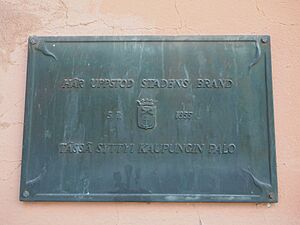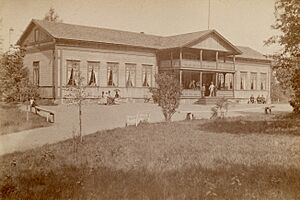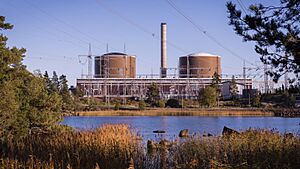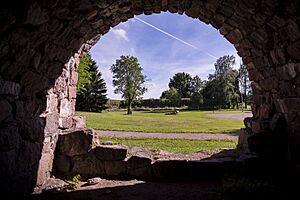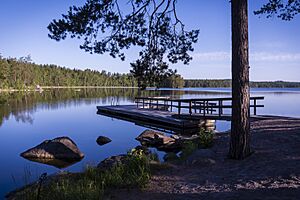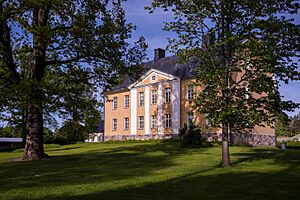Loviisa facts for kids
Quick facts for kids
Loviisa
|
||
|---|---|---|
|
Town
|
||
| Loviisan kaupunki Lovisa stad |
||
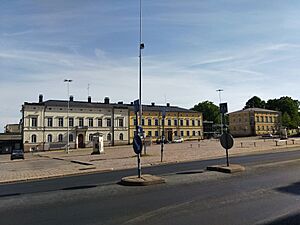
Loviisa townhall Square
|
||
|
||
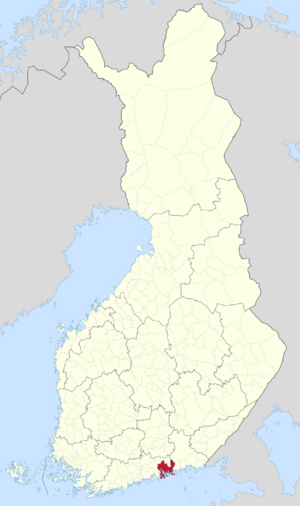
Location of Loviisa in Finland
|
||
| Country | ||
| Region | Uusimaa | |
| Sub-region | Loviisa sub-region | |
| Charter | 1745 | |
| Named for | Louisa Ulrika of Prussia | |
| Area
(2018-01-01)
|
||
| • Total | 1,751.52 km2 (676.27 sq mi) | |
| • Land | 819.82 km2 (316.53 sq mi) | |
| • Water | 931.92 km2 (359.82 sq mi) | |
| Area rank | 95th largest in Finland | |
| Population
(2023-12-31)
|
||
| • Total | 14,458 | |
| • Rank | 78th largest in Finland | |
| • Density | 17.64/km2 (45.7/sq mi) | |
| Population by native language | ||
| • Finnish | 55.2% (official) | |
| • Swedish | 39% (official) | |
| • Others | 5.7% | |
| Population by age | ||
| • 0 to 14 | 13.5% | |
| • 15 to 64 | 57% | |
| • 65 or older | 29.5% | |
| Time zone | UTC+02:00 (EET) | |
| • Summer (DST) | UTC+03:00 (EEST) | |
| Postal code |
07900
|
|
| Area code(s) | 019 | |
| Climate | Dfb | |
Loviisa is a charming town on Finland's southern coast. It's located in the eastern part of the Uusimaa region. About 14,000 people live in Loviisa, making it a medium-sized municipality in Finland.
Loviisa is about 90 kilometers (56 miles) from Helsinki, Finland's capital. The town covers a large area, including land and water. It's known for being a bilingual municipality, meaning both Finnish and Swedish are official languages. Most people speak Finnish, but a good number also speak Swedish.
The town was founded in 1745 as a border fortress. It was first called Degerby. Later, King Adolf Frederick of Sweden renamed it Loviisa in 1752. He named it after his wife, Lovisa Ulrika. Many of the old fortifications are still standing today. Loviisa is also home to two of Finland's nuclear reactors at the Loviisa Nuclear Power Plant.
Contents
Discover Loviisa's History
Loviisa has a long and interesting past, from its founding as a fortress town to its development into a modern city.
How Loviisa Began
The town of Degerby was started in 1745. It was built as a frontier and fortress town. This was important because Finland needed a new trading town after the border moved in 1743. The old trading town, Hamina, was no longer in Finland.
In 1752, King Adolf Frederick of Sweden visited Degerby. He decided to rename the town Loviisa after his wife, Queen Louisa Ulrika of Prussia.
Building Fortresses
In 1748, work began on the Loviisa fortress. However, it was hard to finish because of money problems. Only some parts of the outer walls were built. You can still see parts of these old walls today.
At the same time, the Svartholm fortress was built south of the town. This sea fortress was meant to protect Loviisa from the sea. It also provided a safe place for Sweden's coastal ships.
The Great Fire of 1855
The year 1855 was a dramatic time for Loviisa. On July 5, a big fire broke out in the town. It destroyed a large part of the old town center. About 70 buildings and the wooden church were burned down.
The day before, the English fleet had attacked Svartholm. The fortress was destroyed. Even though there was fighting, the fire in the town was not caused by the warships.
After the fire, people thought about moving the town. But in 1856, it was decided to rebuild Loviisa in the same spot. The town was rebuilt with new plans.
Loviisa as a Spa Town
In the 1860s, Loviisa started to become a spa town. People came to relax and enjoy the "health springs." A main building for the waterworks was built in 1865. A restaurant was also opened.
Loviisa was a popular spa town until World War I. The spa business helped the town's economy. It also brought a rich cultural life, especially music.
Early Industries and Transport
Before the 1880s, Loviisa's main income came from trade and crafts. There was a tobacco factory since the 1750s. A state alcohol distillery also started in the late 1770s. In 1858, a beer brewery was founded.
Real industrial growth began in 1882 with a steam-powered sawmill. By the early 1900s, it employed over a hundred people. A cardboard factory opened in 1912. It became the second-largest employer. A railway line to Lahti was completed around this time. This helped industries grow.
Loviisa in the 20th Century
World War I brought challenges like unemployment and rising food prices. The sawmill closed, and harbor activity slowed down. There were also local disagreements about food supplies and workers' rights.
In 1918, Loviisa saw some difficult times. There were conflicts between different groups of people in Finland. Loviisa was affected by these events. Later that year, German troops arrived in Valko. They left in December 1918 after Germany lost World War I.
The spa reopened in 1919. Many visitors came in the early 1920s. However, visitor numbers dropped later. In 1936, the main spa building was destroyed in a fire and was not rebuilt.
During World War II (Winter War and Continuation War), Loviisa was mostly safe from direct fighting. However, there were air raid alarms. Some people from Loviisa were lost during the wars.
After the wars, a successful shipping business grew in Loviisa. It employed many people, helping the town's economy.
Modern Loviisa: Growth and Power
Loviisa's land area more than doubled between 1920 and 1970. Nearby areas like Antinkylä and Valko joined Loviisa. The island of Hästholmen also joined Loviisa in 1969. This was because a nuclear power plant was planned there.
Building the nuclear power plant was very important for Loviisa. Construction started in 1970. The first unit opened in 1977, and the second in 1980. These power plants have been very successful.
In the 1980s, a large grain storage facility was built at the Valko harbor. New roads were also built to improve transport. In 2010, the nearby municipalities of Liljendal, Pernå, and Ruotsinpyhtää joined Loviisa. This made Loviisa a larger municipality.
In 2023, Loviisa hosted the national Asuntomessut fair. This event showcased new homes and living ideas in the Kuningattarenranta area.
Exploring Loviisa's Geography
Loviisa is located on the coast, with a mix of land, inland waters, and sea.
Loviisa's Central Area
The Esplanadi area in Loviisa, around the market square, is a special cultural area. It has important buildings like the pink city hall (built 1862) and the Neo-Gothic Loviisa church (built 1865). Finland's oldest surviving wooden social club is also here.
Historical parts of the town center include Alakaupunki, Garnisoni, and Uusikaupunki. Alakaupunki was saved from the 1855 fire. It has a building from the 1690s, one of Finland's oldest wooden houses. Uusikaupunki was built for workers in the early 1900s.
The Kuningattarenportti ("Queen's gate") area is a new shopping and business area. A new residential area, Kuningattarenranta, is being built by the Loviisanlahti bay. This area hosted the 2023 Asuntomessut fair.
Nearby Towns and Villages
Loviisa has seven other urban areas besides the main town. Three of these are old parishes: Liljendal, Pernå, and Ruotsinpyhtää. The St. Michael's church in Pernå, built in the 15th century, is Loviisa's oldest building.
Two areas, Koskenkylä and Ruotsinpyhtää parish, grew around old ironworks. The Strömfors ironworks in Ruotsinpyhtää is now a tourist spot. Koskenkylä and Tesjoki are the largest areas outside the main town, each with about a thousand people.
Countryside and Islands
Loviisa has many beautiful manors, especially in the western part. Some are very old, dating back to the Middle Ages. Most manors are privately owned, but a few are partly open to visitors.
There are also many villages. Fasarby is a medieval village with old houses. Horslök and Härkäpää are island villages that have kept their old look from the early 1900s. Härkäpää has a 19th-century windmill.
Sarvisalo is Loviisa's largest island. It has a permanent connection to the mainland. Hästholmen island is known for the Loviisa nuclear power plant. The Svartholm fortress is a famous tourist spot. It was restored in the 1960s and is now open to visitors.
What to See and Do in Loviisa
Loviisa offers many interesting places to visit and activities.
Historic Sights
The sea fortress of Svartholm is south of the city. It was built to protect Loviisa from the sea. After being damaged in the 1800s, it was restored. Today, you can take guided tours and enjoy a restaurant there. A ferry boat goes regularly between Loviisa and Svartholm.
Loviisa is also famous for its Old Town. It was saved from the big fire of 1855. Here you can find one of Finland's oldest wooden houses, dating from the 17th century. The current Neo-Gothic church was opened in 1865.
Fun Events
Loviisa is lively in the summer! Popular events include:
- Historical Houses of Loviisa: An event about traditional house building.
- Small Ships' Race: A festival for traditional sailing ships.
- Loviisa Day: Celebrated on August 25.
- The King Arrives in Loviisa: A weekend celebrating the 18th century.
In autumn, there are the Sibelius Days, celebrating music. The Night of the Ancient Fires is also held. Around October and November, the Kekri event takes place at the Strömfors ironworks. In winter, you can visit "Christmas Homes of Old Times" and Christmas markets.
Asuntomessut 2023
The national Asuntomessut fair was held in Loviisa from July 7 to August 6, 2023. It took place in Kuningattarenranta, a new residential area. Many homes there have their own beaches or sea views. The fair showed off new housing ideas, including floating houses and glass greenhouses.
Loviisa's Economy
Loviisa's economy relies on tourism, its port, and the nuclear power plant. The port in Valko handles timber and other goods. It has good connections to major highways and a train line to Lahti.
The city of Loviisa is the biggest employer, with over a thousand workers. The largest private employer is Fortum Power and Heat Oy, which runs the nuclear power plant. It employs over 500 people. Another big employer is Loval, which makes electronic parts.
There are industrial areas throughout the municipality. These include small businesses, repair shops, and factories making various products like wood elements, packaging, and chemicals.
Schools and Learning
Loviisa has 13 primary schools, some Finnish-speaking and some Swedish-speaking. There are also two high schools: Loviisan lukio (Finnish) and Lovisa Gymnasium (Swedish). A bilingual folk high school offers classes for all ages.
Loviisa has invested in new school buildings. A new primary school was built in 2014. In Koskenkylä, a new bilingual central school was completed in 2020. The new Swedish-speaking senior primary school, Lovisavikens skola, opened in late 2020.
Sports and Activities
Loviisa offers many sports clubs and places to exercise.
Sport Clubs
- FC Loviisa: A football club.
- Loviisan Tor: Focuses on floorball, cross-country skiing, badminton, and athletics.
- Loviisan Tenniskerho: For tennis.
- Hokki Basket: For basketball.
- There are also ice hockey, figure skating, judo, taekwondo, and shooting clubs.
Exercise Places
The Loviisa exercise hall is near the city center. There are also smaller halls in Liljendal and Valko. You can find private gyms and municipal halls.
Loviisa has a padel hall and a bowling alley. There's an ice rink and an astroturf field in Rauhala. Sports fields are available in the city center and other areas. You can play tennis, padel, and volleyball at Casinopuisto park. There's an 18-hole golf course in Rönnäs.
Race Track
The Loviisa race track is very close to the city center. It was built in the 1950s. Horse races are held here every summer. It's also used for training horses year-round.
Hiking Routes
You can enjoy walking routes like Ehrensvärdinpolku and Myllyharju in the city center. These are about two kilometers long. Longer exercise paths are available outside the center, which become ski tracks in winter.
The Kukuljärvi hiking route is near the Strömfors ironworks. It's about eight kilometers long and has barbecue spots. The Kallen kierros hiking route in Liljendal is 11.5 kilometers long and easier to walk.
Culture and Arts
Loviisa has a vibrant cultural scene with museums, libraries, and art.
Museums
The Loviisa city museum started in 1904. Its main building is the Komendantintalo house, built in 1755. It shows the town's history. The smithy museum at Strömfors ironworks shows how smiths worked. The Viirilä homestead museum displays old peasant life.
The Maritime Museum in Laivasilta shows Loviisa's sea history. It has ship models and old maritime items. The old harbor tugboat Onni is also part of the museum. Other museums include the Jokela homestead museum and the "Finland's smallest shop museum."
Libraries
Loviisa's main library is now in Alakaupunki. There are also local libraries in Tesjoki, Liljendal, and the Pernå parish. A library bus travels around the city.
Visual Art
Loviisa has art galleries open all year. Galleria Theodor and Almintalo host exhibitions. The colorful home gallery of artist Riitta Nelimarkka is in the Bonga castle. Galleri Emilie shows art by Kristina Elo.
In summer, you can find exhibitions at Laivasilta and the Strömfors ironworks. The Loviisan Kameraseura (photography club) has its own space and shows photos. You can also study visual art at the Loviisa art school.
Music and Dance
The Porvoo region's music academy offers music education in Loviisa. It has a bilingual children's choir. The Loviisa city orchestra, founded in 1888, is a hobby-based wind instrument orchestra.
The Loviisa dance academy teaches children's dance, modern dance, and classic ballet. It offers a hobby for all ages.
Theatre
Loviisa has several summer and hobbyist theaters. The Loviisa theatre, founded in 1978, performs in different locations. The Ruukinmylly summer theatre at the Strömfors ironworks has a roofed stage.
The Swedish-speaking Lurens sommarteater is known for its rotating stage. Local theater groups also perform in Liljendal.
Healthcare and Safety
Loviisa has a municipal health center with a hospital department. For more serious care, citizens can go to the Kymenlaakso central hospital. Loviisa is part of the Helsinki and Uusimaa Hospital District.
Rescue operations are handled by the Eastern Uusimaa rescue department. There are also ten voluntary fire brigades in the Loviisa area. The Loviisa Nuclear Power Plant has its own industrial fire brigade.
Getting Around Loviisa
Highway 6 goes north from Loviisa towards Kouvola. It branches off from Highway 7 (E18), which connects Loviisa to Porvoo.
Famous People from Loviisa
- Toivo Mäkelä (1909–1979), an actor
- Jaana Toivari-Viitala (1964–2017), an egyptologist
- Eva Wahlström (born 1980), a professional boxer
- Victoria Åberg (1824–1892), a painter
Mikael Agricola, known as the father of the Finnish literary language, was born in the village of Torsby in Pernå, which is now part of Loviisa.
Loviisa's Sister Cities
Loviisa has "twin towns" or "sister cities" in other countries. This helps build friendships and understanding between different places. Loviisa is twinned with cities in:
 Fjallabyggð (Ólafsfjörður), Iceland
Fjallabyggð (Ólafsfjörður), Iceland Haapsalu, Estonia
Haapsalu, Estonia Hillerød, Denmark
Hillerød, Denmark Horten, Norway
Horten, Norway Karlskrona, Sweden
Karlskrona, Sweden Kohila, Estonia
Kohila, Estonia Paks, Hungary
Paks, Hungary Varash, Ukraine
Varash, Ukraine
Images for kids
See also
 In Spanish: Loviisa para niños
In Spanish: Loviisa para niños



